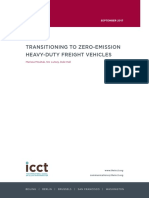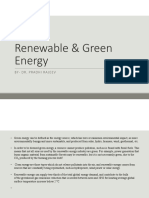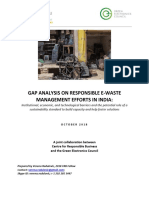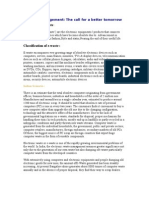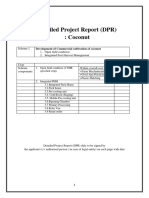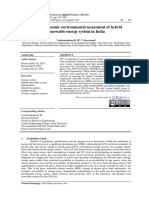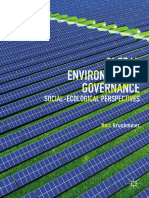Evs Project
Evs Project
Uploaded by
Ankush ShirbhateCopyright:
Available Formats
Evs Project
Evs Project
Uploaded by
Ankush ShirbhateCopyright
Available Formats
Share this document
Did you find this document useful?
Is this content inappropriate?
Copyright:
Available Formats
Evs Project
Evs Project
Uploaded by
Ankush ShirbhateCopyright:
Available Formats
India:
Addressing Energy Security And Climate Change
Ministry of Environment & Forests Ministry of Power Bureau of Energy Efficiency Government of India
October, 2007
India: Addressing Energy Security and Climate Change
Enabling Access to Clean Energy
Poverty reduction and economic growth are the prime objectives of national policy. Energy is the sine qua non of development. India, with over a billion people, today only produces 660 billion KWh of electricity and over 600 million Indians, a population equal to the combined population of USA and EU, have no access to electricity, and limited access to other clean, modern fuels such as LPG and kerosene. This constrained energy access is reflected, as shown in Figure 1, in the relatively low Human Development Index of India. Enhancing energy supply and access is therefore a key component of the national development strategy.
Per capita energy consumption in India is less than 500 kgoe, compared to the global average of nearly 1,800 kgoe
Fig.1:
Energy consumption is a prime driver of the Human Development Index
Since 2004, the Indian economy has grown at a rate of over 9% per year, supported by an energy growth rate of less than 4% per year
Over the past decade, gains in both poverty reduction and economic growth have been significant, and supported by energy growth which has been significantly lower than the economic growth. This reduced energy intensity of the economy, in the period since 2004, has been marked by an economic growth rate of over 9% per annum, which has been achieved with an energy growth of less than 4% per annum. These policies have been driven by the imperatives of sustainable development, and have, as a co-benefit, led to a
October, 2007
India: Addressing Energy Security and Climate Change
Indias per capita CO emissions are approximately 1 tonne per annum, compared to a world average of 4 tonnes per annum
decline in the intensity of energy use and carbon dioxide emissions as well. Figure 2(a) illustrates the declining trend in energy use and CO2 emissions intensities, and Figure 2 (b) highlights that the energy intensity of the Indian economy compares favourably with those of other major economies.
We are determined that Indias per-capita GHG emissions are not going to exceed those of developed countries even while pursuing policies of development and economic growth. Prime Minister Manmohan Singh, Heiligendamm, 8th June 2007
Fig. 2(a): Emissions and Energy Intensity Trends in India
Fig. 2(b): Total Primary Energy Intensities of the Major Economies
Enhancing Sustainable Development and Mitigating Climate Change
This reduced energy intensity, at the relatively low level of Indias per-capita GDP, has been made possible by a range of factors, including Indias historically sustainable patterns of consumption, enhanced competitiveness, proactive policies to promote energy efficiency, and more recently, the use of the Clean Development Mechanism to accelerate the adoption of clean energy technologies.
October, 2007
India: Addressing Energy Security and Climate Change
(a) Food preferences and high recycling rates have mitigated growth in energy demand, and in CO2 emissions
Patterns of Consumption
Food habits and recycling processes have mitigated growth in energy demand and GHG emissions. The specific GHG emissions from food production and processing are much lower in India than in developed countries, as seen in Figure 3.
Fig. 3: CO2 Emissions from the Food Sector from field (Production) to Table (processed food), excluding cooking
The high ratio of recycling in India, compared to that of other major economies in Figure 4, has also limited the growth in energy use, and GHG emissions, because of the lower demand for virgin material such as steel, aluminum and copper.
Fig. 4: Recycling Ratios in Major Economies
(b) Increased Industrial Energy Efficiency Over the past decade, energy efficiency in Indian industry has increased steadily. In the major energy-consuming industrial sectors, such as cement, steel, aluminum, fertilizers, etc., average specific energy consumption has been declining because of energy conservation in existing units, and (much more) due to new capacity
October, 2007
India: Addressing Energy Security and Climate Change
In almost every industrial sector, some of the worlds most energy-efficient units are located India
addition with state-of-the-art technology. For example, as shown in Figures 5(a) and (b), the specific energy consumption of Indian cement plants and of Indian iron & steel plants has been declining rapidly. In the cement sector, the specific energy consumption of the mostefficient plants is now comparable to that of the most efficient plants in the world.
Figure 5(a): Trends in thermal specific energy consumption in the Indian cement sector
Figure 5(b): Trends in specific energy consumption in the Indian iron & steel sector
(c) Policies to Promote Energy Efficiency and Renewable Energy (i) Electricity from Renewables: The Electricity Act, 2003, requires State Electricity Regulatory Commissions to specify a percentage of electricity that the electricity distribution companies must procure from renewable sources. Several Commissions have already
October, 2007
India: Addressing Energy Security and Climate Change
India has over 7,000 MW of wind energy capacity the fourth largest in world. The growth of electricity from renewables has been accelerated by the legislative mandate for its procurement
operationalized this mandate, and also notified preferential prices for electricity from renewables. This has contributed to an acceleration in renewable-electricity capacity addition, and over the past three years, about 2,000 MW of renewable-electricity capacity has been added in India every year, bringing the total installed renewable capacity to over 11,000 MW. Of this, a little over 7,000 MW is based on wind power; India now has the fourth largest installed wind capacity in the world. The National Hydro Energy Policy has resulted in the accelerated addition of hydropower in India, which is now over 35,000 MW.
(ii) Enhancing Efficiency of Power Plants: Coal is the mainstay of Indias energy economy, and coal-based power plants account for about two-thirds of the total electric generation installed capacity of about 135,000 MW. In addition, the Electricity Regulatory Commissions are also linking tariffs to efficiency enhancement, thus providing an incentive for renovation and modernization. New plants are being encouraged to adopt more efficient and clean coal technologies, and four new plants under construction have adopted the more-efficient supercritical technology for power generation. (iii) Introduction of Labeling Programme for Appliances: An energy labeling programme for appliances was launched in 2006, and comparative starbased labeling has been introduced for fluorescent tubelights, air conditioners, and distribution transformers. Figure 6 shows labels for refrigerators and tubelights. The labels provide information about the energy consumption of an appliance, and thus enable consumers to make informed decisions. Almost all fluorescent tubelights sold in India, and about two-thirds of the refrigerators and air conditioners, are now covered by the labeling programme.
October, 2007
India: Addressing Energy Security and Climate Change
Fig. 6: Energy Labels for Refrigerators and Fluorescent Lamps
Application of ECBC reduced the energy demand by more than 50% in a new building being constructed near Delhi
(iv) Energy Conservation Building Code: An Energy Conservation Building Code (ECBC) was launched in May, 2007, which addresses the design of new, large commercial buildings to optimize the buildings energy demand. Commercial buildings are one of the fastest growing sectors of the Indian economy, reflecting the increasing share of the services sector in the economy. Nearly one hundred buildings are already following the Code, and compliance with it has also been incorporated into the Environmental Impact Assessment requirements for large buildings. (v) Energy Audits of Large Industrial Consumers: In March 2007, the conduct of energy audits was made mandatory in large energy-consuming units in nine industrial sectors. These units, notified as designated consumers are also required to employ certified energy managers, and report energy consumption and energy conservation data annually. (d) Accelerated Introduction of Clean Energy Technologies through the CDM Over 700 CDM projects have been approved by the CDM National Designated Authority, and about 300 of these have been registered by the CDM Executive Board. The registered projects have already resulted in over 27 million tones of certified CO2 emissions reductions, and directed investment in renewable energy and energy projects by reducing the perceived risks and uncertainties of these new technologies, thereby accelerating their adoption.
The Clean Development Mechanism has accelerated the diffusion of renewable energy and energy efficient technologies by mitigating some of the risk associated with the adoption of new technologies
October, 2007
India: Addressing Energy Security and Climate Change
Adaptation to Climate Impacts
The adverse impacts of current climate already threaten the livelihoods of many Indians, especially the poorest. Current government expenditure on adaptation to climate variability, as shown in Figure 7, already exceeds 2% of the GDP, with agriculture, water resources, health and sanitation, forests, coastal-zone infrastructure and extreme weather events, being specific areas of concern.
India is especially vulnerable to the adverse impacts of climate, and over 2% of GDP is currently spent on measures to adapt to these impacts
Fig. 7: Expenditure on Adaptation Programmes in India
The broad areas where adaptation programmes have been developed include: (a) Crop Improvement
Programmes address technical issues, such as development of arid-land crops and pest management, as well as capacity building of extension workers and NGOs to support better and vulnerability-reducing practices. (b) Drought Proofing Programmes seek to minimize the adverse effects of drought on production of crops and livestock, and on productivity of land, water and human resources, so as to ultimately lead to drought proofing of the affected areas. They also aim to promote overall economic development and improve the socio-economic conditions of the resource poor and disadvantaged sections inhabiting the programme areas.
October, 2007
India: Addressing Energy Security and Climate Change
(c) Health The prime objective of these programmes is the surveillance and control of vector borne diseases such as Malaria, Kala-azar, Japanese Encephalitis, Filaria and Dengue. Programmes also provide for emergency medical relief in the case of natural calamities, and train and develop human resources for these tasks. (d) Risk Financing Two risk-financing programmes support adaptation to climate impacts. The Crop Insurance scheme supports the insurance of farmers against climate risks, and the Credit Support Mechanism facilitates the extension of credit to farmers, especially in instances such as crop failure due to climate variability. (e) Disaster Management The National Disaster Management programme provides grants-in-aid to victims of disasters, and manages disaster relief operations. It also supports proactive disaster prevention programmes, including dissemination of information and training of disaster-management staff. (f) Livelihood Preservation Programmes support income diversification, as well as minimum employment guarantees in order to enable sustainability of livelihoods, including in response to loss of livelihoods due to the adverse impacts of climate.
Mainstreaming Climate Change in Sustainable Development
Government initiatives for the diffusion of renewable energy and energy-efficient technologies, joint forest management, water resources management, agricultural extension services, web-enabled services for farmers and rural areas, and environmental education in schools and colleges represent a broad spectrum of efforts to integrate climate change concerns in sustainable development. This integration is institutionalized through specialized institutions, such as the Ministry of New & Renewable Energy, the Bureau of Energy Efficiency, and the Technology Information,
October, 2007
India: Addressing Energy Security and Climate Change
The Ministry of New & Renewable Energy, the Bureau of Energy Efficiency, and the Technology Information Forecasting & Assessment Council, have specific mandates to promote clean energy technologies
Forecasting & Assessment Council, with specific mandates to promote climate friendly technologies. The National Environment Policy, 2006, provides the basis for the integration of environmental considerations in the policies of various sectors. The Policy Statement for Abatement of Pollution, 1992, stresses the prevention of pollution at the source based on the polluter pays principle. The Forest Policy, 1988, highlights environmental protection through preservation and restoration of the ecological balance. The policy seeks to substantially increase the forest cover in the country through afforestation programmes. The statutory framework for the environment and energy efficiency includes the Indian Forests Act, 1927, the Water (Prevention and Control of Pollution) Act, 1974, the Air (Prevention and Control of Pollution) Act, 1981, the Forest (Conservation) Act, 1980, and the Environment (Protection) Act, 1986. Other enactments include the Public Liability Insurance Act, 1991, the National Environment Tribunal Act, 1995, the National Environment Appellate Authority Act, 1997, the Energy Conservation Act, 2001, and the Electricity Act, 2003. The courts have also elaborated on the concepts relating to sustainable development, and the polluter pays and precautionary principles. In India, matters of public interest, particularly pertaining to the environment, are articulated effectively through a vigilant media, an active NGO community, and through the judicial process which has recognized the citizens right to a clean environment as a component of the right to life and liberty. Addressing climate change mitigation and adaptation involves many stakeholders, cuts across short and long timeframes, and requires that all development projects be assessed for their sensitivity to climate concerns. This integration of climate concerns in the development process has been mainstreamed in India through high-level multistakeholder committees. The National Committee to Assess the Impacts of Climate Change is chaired by the Principal Scientific Advisor to the Prime Minister, and includes meteorologists, climate modelers, hydrologists, energy economists, as well as representatives of key Ministries. The Committee is evaluating the impact of climate change on key development
October, 2007
10
India: Addressing Energy Security and Climate Change
Climate change is integrated into the national development planning process, and overseen by the Prime Ministers Council on Climate Change
activities, and assessing options to mitigate climate risks. At the national level, the integration of climate change in national development is guided by the Prime Ministers Council on Climate Change, which includes representation of key Ministries, as well as experts, and representatives of industry and of media. The Council provides overall strategic guidance on mainstreaming climate change in development, identifies key intervention priorities, and monitors the implementation of these interventions.
October, 2007
You might also like
- LEED v4 BD+C Rating System Credit MatrixDocument2 pagesLEED v4 BD+C Rating System Credit Matrixadil271100% (2)
- Evs ProjectDocument12 pagesEvs ProjectDivyansh GautamNo ratings yet
- Evs ProjectDocument28 pagesEvs ProjectAlbus Severus60% (5)
- EVSDocument28 pagesEVSH8000100% (1)
- Hospital Management SystemDocument13 pagesHospital Management SystemOmkarNo ratings yet
- Premium Bike Market in IndiaDocument5 pagesPremium Bike Market in Indiaarun_gauravNo ratings yet
- New Renewable Energy in India: Harnessing The Potential: Export-Import Bank of IndiaDocument175 pagesNew Renewable Energy in India: Harnessing The Potential: Export-Import Bank of Indiakittu99887No ratings yet
- Renewable Energy in India - WikipediaDocument60 pagesRenewable Energy in India - WikipediadhavalgiriNo ratings yet
- G.O. Ms - No.17: 2021-2026 Orders Issued-RegDocument9 pagesG.O. Ms - No.17: 2021-2026 Orders Issued-RegBavanari SettyNo ratings yet
- ICCT Zero Emission Freight Trucks White PaperDocument59 pagesICCT Zero Emission Freight Trucks White PaperChinh VuNo ratings yet
- Evs Joural Assignment STD XiiDocument5 pagesEvs Joural Assignment STD XiiTryNo ratings yet
- Policy Renewable West Bengal 2012Document42 pagesPolicy Renewable West Bengal 2012Abhishek SenguptaNo ratings yet
- Presentation On Wind MillDocument133 pagesPresentation On Wind MillRAJENDRA TELVEKARNo ratings yet
- Aicte BodyDocument23 pagesAicte BodyBharath ShettyNo ratings yet
- E-Waste Generation and Their Impacts On Health and Environment A Study Over Gazipur District, BangladeshDocument8 pagesE-Waste Generation and Their Impacts On Health and Environment A Study Over Gazipur District, BangladeshInternational Journal of Innovative Science and Research Technology100% (1)
- Evs ProjectDocument48 pagesEvs ProjectBhargav Bardipurkar82% (11)
- Green Energy TechnologyDocument38 pagesGreen Energy TechnologyvermadeenNo ratings yet
- Renewable Energy in India: Status and Future ProspectsDocument24 pagesRenewable Energy in India: Status and Future ProspectsShounak RoyNo ratings yet
- Electronics Systems Design and Manufacturing Eco System: Manufacturing Eco System: Next Big Leap in IndiaDocument17 pagesElectronics Systems Design and Manufacturing Eco System: Manufacturing Eco System: Next Big Leap in Indiaghatakp2069No ratings yet
- Rajasthan Solar Energy Policy 2019Document46 pagesRajasthan Solar Energy Policy 2019V S MITTALNo ratings yet
- Sustainable Development in SingaporeDocument5 pagesSustainable Development in SingaporeSuffyan OthmanNo ratings yet
- Biomass - S Dhingra TERI PDFDocument17 pagesBiomass - S Dhingra TERI PDFIshan TiwariNo ratings yet
- Energy Generation Using Piezoelectric Materials On RoadDocument5 pagesEnergy Generation Using Piezoelectric Materials On RoadMohit nemadeNo ratings yet
- 1st Fortnight ReportDocument3 pages1st Fortnight Reportvaibhav_stupifyNo ratings yet
- Evs Project Biodiversity PDFDocument2 pagesEvs Project Biodiversity PDFBrittany36% (11)
- E WasteDocument10 pagesE WasteVarsha RkNo ratings yet
- Solar Cell: Side of Solar Cell Are Transparent Conducting Film For Allowing To Light To EnterDocument8 pagesSolar Cell: Side of Solar Cell Are Transparent Conducting Film For Allowing To Light To EnterAman MishraNo ratings yet
- CircularEconomy EWaste CRB GEC GapAnalysisDocument34 pagesCircularEconomy EWaste CRB GEC GapAnalysisAnant SagarNo ratings yet
- Seminar On: E-Waste ManagementDocument19 pagesSeminar On: E-Waste Managementch.tejaramNo ratings yet
- Elements of Solid Waste ManagementDocument11 pagesElements of Solid Waste ManagementPrajakta PawarNo ratings yet
- Effects of Population Growth On Our EnvironmentDocument10 pagesEffects of Population Growth On Our EnvironmentSubhas Roy0% (1)
- Bio Gas As Alternet Fuel in Ic EngineDocument20 pagesBio Gas As Alternet Fuel in Ic EngineShizuka NaNo ratings yet
- Solar Pumps Project Proposal For Rajasthan.Document2 pagesSolar Pumps Project Proposal For Rajasthan.Manoj Kumar AcharyNo ratings yet
- Evs Project PPT FinalDocument16 pagesEvs Project PPT Finalbhumika makhijaNo ratings yet
- Solar EnergyDocument68 pagesSolar EnergyNirav GuptaNo ratings yet
- Bhopal JNNURMDocument239 pagesBhopal JNNURMGaurav Nemade100% (2)
- National Renewable Energy Act (Nre), 2015Document13 pagesNational Renewable Energy Act (Nre), 2015HarshBachhilNo ratings yet
- Business Idea-Managing Household E-WasteDocument17 pagesBusiness Idea-Managing Household E-Wastetaned8787No ratings yet
- E WasteDocument8 pagesE Wasteanon-815109100% (1)
- Energy India 2020Document17 pagesEnergy India 2020Deepak Saheb Gupta50% (2)
- Watter Tarrif enDocument30 pagesWatter Tarrif enTauseefNo ratings yet
- Renewable EnergyDocument31 pagesRenewable EnergyAnjan MohapatroNo ratings yet
- Profile of Nagapattinam DistrictDocument31 pagesProfile of Nagapattinam DistrictjayveeNo ratings yet
- Detailed Project Report (DPR) : Coconut: Development of Commercial Cultivation of CoconutDocument122 pagesDetailed Project Report (DPR) : Coconut: Development of Commercial Cultivation of Coconutnitya gNo ratings yet
- A Guideline For Sustainable MongoliaDocument80 pagesA Guideline For Sustainable MongoliajvrjeeNo ratings yet
- OkhlaDocument55 pagesOkhlaPoojit Popli50% (2)
- POM Assignment SubmissionDocument5 pagesPOM Assignment SubmissionAakriti VermaNo ratings yet
- Techno Economic Environmental Assessment of Hybrid Renewable Energy System in IndiaDocument20 pagesTechno Economic Environmental Assessment of Hybrid Renewable Energy System in IndiaInternational Journal of Advances in Applied Sciences (IJAAS)No ratings yet
- A Study On Renewable Energy Resources in IndiaDocument39 pagesA Study On Renewable Energy Resources in IndiaDevendra SharmaNo ratings yet
- My Evs ProjectDocument14 pagesMy Evs ProjectYugandhara Sudhakar Patil25% (8)
- Technology For A Low Carbon Future Full ReportDocument37 pagesTechnology For A Low Carbon Future Full ReportGreatNo ratings yet
- Project Report ON E-Waste: Bachelor of Business AdministrationDocument30 pagesProject Report ON E-Waste: Bachelor of Business AdministrationDimple GolaitNo ratings yet
- Synopsis PDFDocument7 pagesSynopsis PDFSharda SharmaNo ratings yet
- National Hydrogen Energy MissionDocument3 pagesNational Hydrogen Energy MissionRaj KishoreNo ratings yet
- IT2T4Document2 pagesIT2T4Vyshnavi ThottempudiNo ratings yet
- U.S. Renewable Energy Factsheet CSS03-12 E2018Document2 pagesU.S. Renewable Energy Factsheet CSS03-12 E2018Jose MartinezNo ratings yet
- assenergyDocument11 pagesassenergyhereiswho2No ratings yet
- EADM Chapter 1 NotesDocument13 pagesEADM Chapter 1 NotesDr. Gaurav JainNo ratings yet
- Energy Supply Demand and Environmental Analysis A Case Study of Indian Energy ScenarioDocument6 pagesEnergy Supply Demand and Environmental Analysis A Case Study of Indian Energy ScenariomelgeorgeNo ratings yet
- New Rich Text DocumentDocument4 pagesNew Rich Text DocumentJunaid B TNo ratings yet
- Renewable Energy Technology Unit1editDocument18 pagesRenewable Energy Technology Unit1editsreeramn0No ratings yet
- KKE (Solar Energy - Solar - Basics)Document38 pagesKKE (Solar Energy - Solar - Basics)Iqbal Al FuadyNo ratings yet
- DR Winston McCalla, Lessons From The Caribbean Region Experience, Presentation, 2-2012Document21 pagesDR Winston McCalla, Lessons From The Caribbean Region Experience, Presentation, 2-2012Detlef LoyNo ratings yet
- We Are Intechopen, The World'S Leading Publisher of Open Access Books Built by Scientists, For ScientistsDocument17 pagesWe Are Intechopen, The World'S Leading Publisher of Open Access Books Built by Scientists, For ScientistsRismaNo ratings yet
- Brent Thomas Dusek PortfolioDocument22 pagesBrent Thomas Dusek PortfolioBrent Thomas DusekNo ratings yet
- Biffa 2023 Sustainability ReportDocument60 pagesBiffa 2023 Sustainability ReportpeachyceriNo ratings yet
- Concept Note:: Resentation TranscriptDocument4 pagesConcept Note:: Resentation TranscriptR.S.TiwariNo ratings yet
- Environmental Management Practices and Sustainability of Multinational Companies in IndiaDocument12 pagesEnvironmental Management Practices and Sustainability of Multinational Companies in IndiaMrunmayi PhirkeNo ratings yet
- Class 8 Conservation Chapter Study NotesDocument6 pagesClass 8 Conservation Chapter Study NotesTapas BanerjeeNo ratings yet
- Muller Et Al (2011)Document11 pagesMuller Et Al (2011)Lalisa gatito de AniNo ratings yet
- Professional Engineer Summary StatementDocument4 pagesProfessional Engineer Summary StatementunswshashaNo ratings yet
- Wind Energy (China Case Study)Document21 pagesWind Energy (China Case Study)Yu Chia LimNo ratings yet
- Curriculum Reforms Vision: Basic Education Curriculum FrameworkDocument4 pagesCurriculum Reforms Vision: Basic Education Curriculum FrameworkmilibroNo ratings yet
- Indonesian Rainforests - Rainforest Action NetworkDocument1 pageIndonesian Rainforests - Rainforest Action NetworkStuti Nandan MehtaNo ratings yet
- Full Report Sustainable PDFDocument20 pagesFull Report Sustainable PDFnur ezzatiNo ratings yet
- Icici Bank Esg Report 2023 24Document85 pagesIcici Bank Esg Report 2023 24MichaelRajaNo ratings yet
- 1 s2.0 S0964569123004039 MainDocument16 pages1 s2.0 S0964569123004039 MainHamza HussainNo ratings yet
- Evaluating Climate Change Action For Sustainable Development January 2017Document365 pagesEvaluating Climate Change Action For Sustainable Development January 2017Juan M. Nava DavilaNo ratings yet
- Handbook of Plant-Based Biofuels. Edited by Ashok Pandey - PrefaceDocument2 pagesHandbook of Plant-Based Biofuels. Edited by Ashok Pandey - Prefacechunguao2010No ratings yet
- BRUCKMEIER. Global Environmental GovernanceDocument296 pagesBRUCKMEIER. Global Environmental GovernanceDiogo Ives100% (2)
- Frame 32Document1 pageFrame 32shashank.sahuNo ratings yet
- Test Bank For Environmental Science 14th Edition William Cunningham Mary CunninghamDocument18 pagesTest Bank For Environmental Science 14th Edition William Cunningham Mary CunninghamAndi AnnaNo ratings yet
- SigmaPower Eng Low PDFDocument8 pagesSigmaPower Eng Low PDFAlejandro GarciaNo ratings yet
- Cradle To CradleDocument15 pagesCradle To CradleSanjana KadiyalaNo ratings yet
- Is South Africa Operating in A Safe and Just Space? Using The Doughnut Model To Explore Environmental Sustainability and Social JusticeDocument71 pagesIs South Africa Operating in A Safe and Just Space? Using The Doughnut Model To Explore Environmental Sustainability and Social JusticeOxfamNo ratings yet
- Malaysia's Helios PV Co-Develops Container-Size Solar Solution With Retractable Panels Can Power Typical Office For 15 Hours Off-GridDocument3 pagesMalaysia's Helios PV Co-Develops Container-Size Solar Solution With Retractable Panels Can Power Typical Office For 15 Hours Off-GridWeR1 Consultants Pte LtdNo ratings yet
- Individual Investors' Learning Behavior and Its Impact On Their Herd Bias: An Integrated Analysis in The Context of Stock TradingDocument24 pagesIndividual Investors' Learning Behavior and Its Impact On Their Herd Bias: An Integrated Analysis in The Context of Stock TradingOptimAds DigMarkNo ratings yet
- SINGAPORE Finale CaseDocument4 pagesSINGAPORE Finale CaseYenenehNo ratings yet
- Introducing Business EthicsDocument18 pagesIntroducing Business EthicsAkashdeep GhummanNo ratings yet
- Peace Through Alternative Tourism: Case Studies From Bengal, IndiaDocument21 pagesPeace Through Alternative Tourism: Case Studies From Bengal, IndiaBabu George100% (1)









